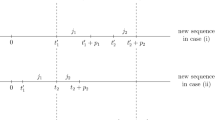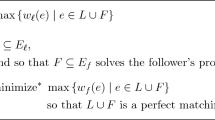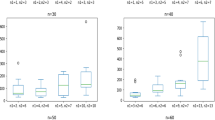Abstract
The linear bottleneck assignment problem (LBAP), which is a variation of the classical assignment problem (CAP), seeks to minimize the longest completion time rather than the sum of the completion times when a number of jobs are to be assigned to the same number of workers. Several procedures have been proposed in the current literature to convert the LBAP into an equivalent CAP and then apply the Hungarian method to solve it efficiently. However, their applicability is limited because some of the elements in the transformed assignment matrix for the CAP can be too large to be handled by most computer programs. In this paper, we suggest a turnpike approach to alleviate the problem so that the conversion methodology will become more useful in practice. A numerical example is provided to demonstrate the superiority of the new algorithm to the existing ones.
Similar content being viewed by others
References
Aneja YP, Punnen AP (1999) Multiple bottleneck assignment problem. Eur J Oper Res 112(1):167–173
Armstrong RD, Jin J (1992) Solving linear bottleneck assignment problems via strong spanning trees. Oper Res Lett 12(3):179–180
Bhatia HL (1977) Time minimizing assignment problem. Systems and Cybernetics in Management 6(3):75–83
Burkard RE, Çela E (1999) Linear assignment problems and extensions. In: Du D-Z, Pardalos PM (eds) Handbook of combinatorial optimization: supplement volume A. Kluwer, Dordrecht, pp 75–149
Burkard RE, Dell’Amico M, Martello S (2009) Assignment problems: revised reprint. Society for Industrial and Applied Mathematics, Philadelphia
Burkard RE, Rendl F (1991) Lexicographic bottleneck problems. Oper Res Lett 10(5):303–308
Burkard RE, Rissner R (2011) Polynomially solvable special cases of the quadratic bottleneck assignment problem. J Comb Optim 22(4):845–856
Burkard RE, Zimmermann U (1977) Weakly admissible transformations. Report No. 77-3, Köln, Germany: Mathematisches Institut, Universität zu Köln
Carpaneto G, Martello S, Toth P (1984) An algorithm for the bottleneck traveling salesman problem. Oper Res 32(2):380–389
Carpaneto G, Toth P (1981) Algorithm for the solution of the bottleneck assignment problem. Computing 27(2):179–187
Carraresi P, Gallo G (1984) A multi-level bottleneck assignment approach to the bus drivers’ rostering problem. Eur J Oper Res 16(2):163–173
De P, Ghosh JB, Wells CE (1992) On the solution of a stochastic bottleneck assignment problem and its variations. Nav Res Logist 39(3):389–397
Derigs U (1984) Alternate strategies for solving bottleneck assignment problems—analysis and computational results. Computing 33(2):95–106
Derigs U, Zimmermann U (1978) An augmenting path method for solving linear bottleneck assignment problems. Computing 19(4):285–295
Dokka T, Kouvela A, Spieksma FCR (2012) Approximating the multi-level bottleneck assignment problem. Oper Res Lett 40(4):282–286
Edmonds J, Fulkerson DR (1970) Bottleneck extrema. Journal of Combinatorial Theory 8(3):299–306
Ford LR Jr, Fulkerson DR (1962) Flows in networks. Princeton University Press, Princeton
Fulkerson, DR, Glicksberg, I, Gross, O (1953). A production line assignment problem. Research Memorandum RM-1102, Santa Monica, CA: Rand Corporation
Garfinkel RS (1971) An improved algorithm for the bottleneck assignment problem. Oper Res 19(7):1747–1751
Garfinkel RS, Gilbert KC (1978) The bottleneck traveling salesman problem: algorithms and probabilistic analysis. J Assoc Comput Mach 25(3):435–448
Garfinkel RS, Nemhauser GL (1970) Optimal political districting by implicit enumeration techniques. Manag Sci 16(8):495–508
Gross, O (1959). The bottleneck assignment problem. Paper P-1630, Santa Monica, CA: Rand Corporation
Hammer PL (1969) Time-minimizing transportation problems. Naval Research Logistics Quarterly 16:345–357
Kuhn HW (1955) The Hungarian method for the assignment problem. Naval Research Logistics Quarterly 2(1–2):83–97
Kuo C-C (2011) Optimal assignment of resources to strengthen the weakest link in an uncertain environment. Ann Oper Res 186(1):159–173
Malhotra R, Bhatia HL, Puri MC (1985) The three dimensional bottleneck assignment problem and its variants. Optimization 16(2):245–256
Mazzola JB, Neebe AW (1988) Bottleneck generalized assignment problems. Engineering Costs & Production Economics 14(1):61–65
Page ES (1963) A note on assignment problems. Comput J 6(3):241–243
Papadimitriou CH, Steiglitz K (1982) Combinatorial optimization: algorithms and complexity. Prentice-Hall, Englewood Cliffs
Pentico DW (2007) Assignment problems: a golden anniversary survey. Eur J Oper Res 176(2):774–793
Ravindran A, Ramaswami V (1977) On the bottleneck assignment problem. J Optim Theory Appl 21(4):451–458
Sokkalingam PT, Aneja YP (1998) Lexicographic bottleneck combinatorial problems. Oper Res Lett 23(1–2):27–33
Srinivasan V, Thompson GL (1976) Algorithms for minimizing total cost, bottleneck time and bottleneck shipment in transportation problems. Naval Research Logistics Quarterly 23(4):567–595
Szwarc W (1971) Some remarks on the time transportation problem. Nav Res Logist 18(4):473–485
Trivedi KS (2002) Probability and statistics with reliability, queuing and computer science applications, 2nd edn. Wiley, New York
Weiss HJ, Gershon ME (1993) Production and operations management, 2nd edn. Allyn and Bacon, Needham Heights
Yechiali U (1968) A stochastic bottleneck assignment. Manag Sci 14(11):732–734
Author information
Authors and Affiliations
Corresponding author
Appendix 1: Proofs of Propositions
Appendix 1: Proofs of Propositions
1.1 Proof of Proposition 1
Suppose that x * = (x 11 *, x 12 *, …, x nn *) is an optimal solution to (M2). Let S = {(i, j): x ij * = 1, 1 ≤ i, j ≤ n}. Since c ij ≥ r i ∀ (i, j) ∈ S, Z * = max {c ij : (i, j) ∈ S} ≥ max {r i : (i, j) ∈ S} = max {r i : 1 ≤ i ≤ n} = r or Z * ≥ r. Similarly, c ij ≥ c j ∀ (i, j) ∈ S and Z * = max {c ij : (i, j) ∈ S} ≥ max {c j : (i, j) ∈ S} = max {c j : 1 ≤ j ≤ n} = c or Z * ≥ c. It follows that Z * ≥ max {r, c} = LB or Z * ≥ LB, which implies that Z * is bounded below by LB.
1.2 Proof of Proposition 4
Call all the elements in [c ij ] greater than c(n 2 − n + 1) inadmissible and replace each of them with an extremely large positive number M. Rank the matrix columns in non-decreasing order of number of admissible elements and label them as [1], [2], …, [n]. Since there are only n − 1 inadmissible elements in [c ij ], column [j] contains at least j admissible elements, 1 ≤ j ≤ n. Beginning with column [1], match the job with the worker associated with any admissible element in the column and cross out the corresponding row and column. Repeat the same procedure on the continuously reduced matrix until the matching in column [n] is made.
Suppose the job-worker assignments determined in this way are represented by w = (w 11, w 12, …, w nn ), where w ij ∈ {0, 1}, \( {\displaystyle \sum_{j=1}^n{w}_{ij}}=1,1\le i\le n \), and \( {\displaystyle \sum_{i=1}^n{w}_{ij}}=1,1\le j\le n \). It is trivial to see that w is a feasible solution to (M2). Furthermore, Z * ≤ Z = max {c ij : w ij = 1, 1 ≤ i, j ≤ n} ≤ c(n 2 − n + 1) = w or Z * ≤ w, which implies that Z * is bounded above by w.
1.3 Proof of Proposition 7
Assume that x * = (x 11 *, x 12 *, …, x nn *) is an optimal solution to the CAP with [f ij ]. To prove the proposition, it suffices to show that x * also solves the LBAP with [e ij ]. Suppose otherwise and y = (y 11, y 12, …, y nn ) is a better feasible solution to the LBAP; that is, \( \underset{1\le i,j\le n}{ \max } \) {e ij : y ij = 1} < \( \underset{1\le i,j\le n}{ \max } \) {e ij : x ij * = 1}. Let t′ and t * be the unique positive integers such that \( \underset{1\le i,j\le n}{ \max } \) {e ij : y ij = 1} = t′ ∈ S(t′) and \( \underset{1\le i,j\le n}{ \max } \) {e ij : x ij * = 1} = t * ∈ S(t *). Further, let σ′ and θ′ be associated with t′ while σ * and θ * be associated with t *. Given t′ < t *, we have f(t′) < f(t *) since f(.) is an increasing function. Also, note that θ * ≥ f(t′) + [θ′ − f(σ′)], which means that the sum of the largest n elements smaller than f(t *) in [f ij ] is greater than or equal to the sum of f(t′) and the largest n − 1 elements smaller than f(t′).
Based on the above discussion, we have \( \begin{array}{l}{\displaystyle \sum_{i=1}^n{\displaystyle \sum_{j=1}^n{f}_{ij}{x}_{ij}^{\ast }}}={\displaystyle \sum_{i=1}^n{\displaystyle \sum_{j=1}^n\left\{{f}_{ij}:{x}_{ij}^{\ast }=1\right\}}}=\underset{1\le i,j\le n}{ \max}\left\{{f}_{ij}:{x_{ij}}^{*}=1\right\}\ \hfill \\ {}+\left[{\displaystyle \sum_{i=1}^n{\displaystyle \sum_{j=1}^n\left\{{f}_{ij}:{x}_{ij}^{\ast }=1\right\}}}\kern.3em -\underset{1\le i,j\le n}{ \max}\left\{{f}_{ij}:{x_{ij}}^{*}=1\right\}\right]=f\left({t}^{*}\right)+\left[{\displaystyle \sum_{i=1}^n{\displaystyle \sum_{j=1}^n\left\{{f}_{ij}:{x}_{ij}^{\ast }=1\right\}}}\kern.3em -\underset{1\le i,j\le n}{ \max}\left\{{f}_{ij}:{x_{ij}}^{*}=1\right\}\right]\ge f\left({t}^{*}\right)+\beta \hfill \\ {}=\left({\theta}^{*}-\beta +1\right)+\beta ={\theta}^{*}+1>{\theta}^{*}\ge f\left(t\prime \right)+\left[\theta \prime -f\left(\sigma \prime \right)\right]=\underset{1\le i,j\le n}{ \max}\left\{{f}_{ij}:{y}_{ij}=1\right\}+\left[\theta \prime -f\left(\sigma \prime \right)\right]\ge \underset{1\le i,j\le n}{ \max}\left\{{f}_{ij}:{y}_{ij}=1\right\}\hfill \\ {}+\left[{\displaystyle \sum_{i=1}^n{\displaystyle \sum_{j=1}^n\left\{{f}_{ij}:{y}_{ij}=1\right\}}}\kern.3em -\underset{1\le i,j\le n}{ \max}\left\{{f}_{ij}:{y}_{ij}=1\right\}\right]={\displaystyle \sum_{i=1}^n\kern5pt {\displaystyle \sum_{j=1}^n\kern5pt \left\{{f}_{ij}:{y}_{ij}=1\right\}}={\displaystyle \sum_{i=1}^n\kern5pt {\displaystyle \sum_{j=1}^n{f}_{ij}{y}_{ij}}}}\hfill \end{array} \) or \( {\displaystyle \sum_{i=1}^n{\displaystyle \sum_{j=1}^n{f}_{ij}{x}_{ij}^{\ast }}}\ge {\displaystyle \sum_{i=1}^n{\displaystyle \sum_{j=1}^n{f}_{ij}{y}_{ij}}} \), which implies that y is a better solution to the CAP than x. Since this a contradiction to the assumption that x * is an optimal solution, the proof is complete.
Rights and permissions
About this article
Cite this article
Kuo, CC., Nicholls, G. A turnpike approach to solving the linear bottleneck assignment problem. Int J Adv Manuf Technol 71, 1059–1068 (2014). https://doi.org/10.1007/s00170-013-5464-1
Received:
Accepted:
Published:
Issue Date:
DOI: https://doi.org/10.1007/s00170-013-5464-1




